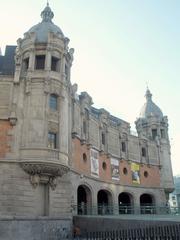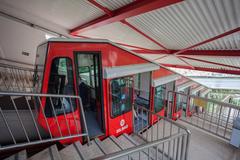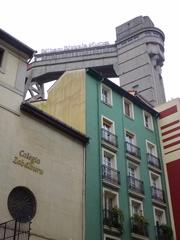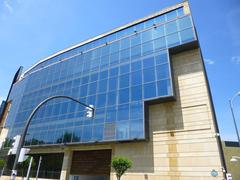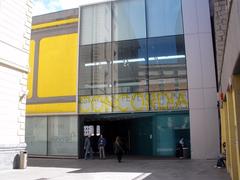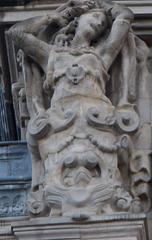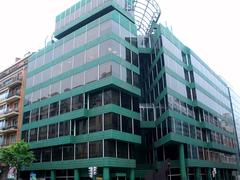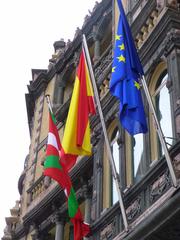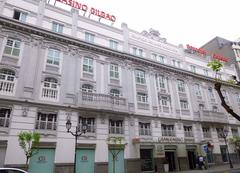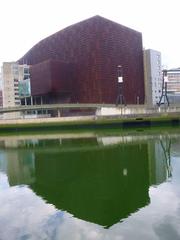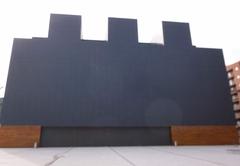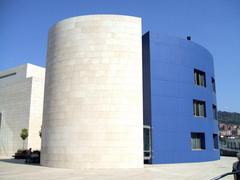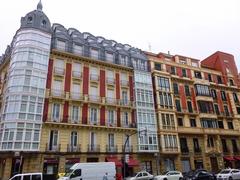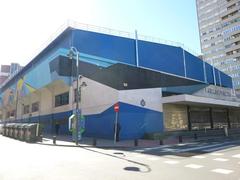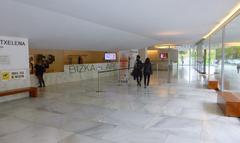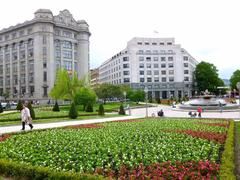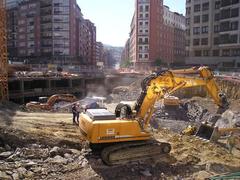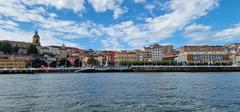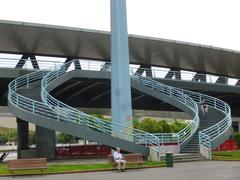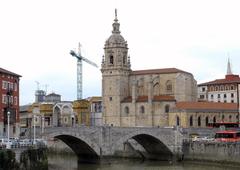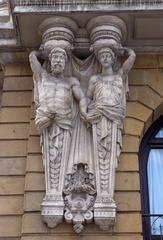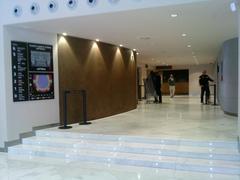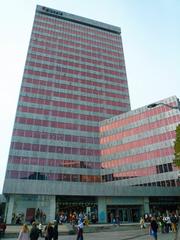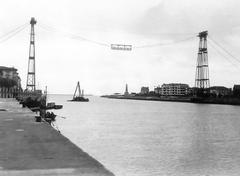Visiting Paseo Puerta de Bizkaia in Bilbao: Hours, Tickets, and Tips
Date: 17/07/2024
Introduction
The Paseo Puerta de Bizkaia, situated at the heart of Bilbao, Spain, is a landmark that encapsulates the city’s rich cultural and historical lineage. Originating in the 19th century, this area has witnessed Bilbao’s transformation from a small port town into a bustling industrial hub, and eventually into a cultural epicenter. The Vizcaya Bridge, constructed in 1893 and a UNESCO World Heritage Site, is one of the many iconic structures that adorn this area, representing an engineering marvel from the Industrial Revolution (UNESCO). Over the years, the Paseo Puerta de Bizkaia has evolved architecturally, showcasing a blend of neoclassical, modernist, and contemporary styles. This area has not only been a witness to the industrial growth but also endured significant events like the Spanish Civil War, which left a profound impact on the region (History.com). Today, the Paseo Puerta de Bizkaia stands as a symbol of Bilbao’s resilience and cultural renaissance, especially since the construction of the Guggenheim Museum Bilbao in 1997, which marked a pivotal moment in the city’s transformation into a global cultural icon (Guggenheim.org). This guide serves as a comprehensive resource for visitors, covering the history, visiting hours, ticket information, travel tips, and nearby attractions in the Paseo Puerta de Bizkaia.
Table of Contents
- Introduction
- Origins and Early Development
- Industrial Revolution and Urban Expansion
- Architectural Evolution
- The Spanish Civil War and Post-War Reconstruction
- Late 20th Century to Present
- Visiting Information
- Cultural Significance
- Preservation and Future Prospects
- FAQ
- Conclusion
Origins and Early Development
The origins of the Paseo Puerta de Bizkaia can be traced back to the early 19th century when Bilbao was undergoing rapid industrialization. The city, known for its iron and steel industries, was expanding, and new urban developments were necessary to accommodate the growing population and economic activities.
Industrial Revolution and Urban Expansion
During the Industrial Revolution, Bilbao transformed from a small port town into a bustling industrial hub. The Paseo Puerta de Bizkaia was part of this transformation, serving as a key thoroughfare that connected various parts of the city. The construction of the Vizcaya Bridge, also known as the Puente Colgante, in 1893, further enhanced the significance of this area. The bridge, a UNESCO World Heritage Site, is an engineering marvel and the world’s oldest transporter bridge. It facilitated the movement of goods and people across the Nervión River, boosting Bilbao’s industrial growth (UNESCO).
Architectural Evolution
The architectural landscape of Paseo Puerta de Bizkaia reflects the eclectic mix of styles that emerged during Bilbao’s growth. The area features a blend of neoclassical, modernist, and contemporary buildings. Notable structures include the Palacio de la Diputación Foral de Bizkaia, an impressive neoclassical building constructed in 1900, which serves as the seat of the provincial government of Biscay (Bizkaia.eus).
The Spanish Civil War and Post-War Reconstruction
The Spanish Civil War (1936-1939) had a profound impact on Bilbao and the Paseo Puerta de Bizkaia. The city was a stronghold for the Republican forces, and it suffered significant damage during the conflict. The bombing of Guernica, a nearby town, by German and Italian forces allied with Franco’s Nationalists, is one of the most tragic events of the war and had repercussions throughout the Basque Country, including Bilbao (History.com).
After the war, Bilbao underwent a period of reconstruction and modernization. The Paseo Puerta de Bizkaia was revitalized, with new buildings and infrastructure projects aimed at restoring the city’s economic vitality. The post-war era also saw the rise of the Basque nationalist movement, which sought greater autonomy for the Basque Country within Spain.
Late 20th Century to Present
The latter half of the 20th century marked a period of significant transformation for Bilbao and the Paseo Puerta de Bizkaia. The decline of traditional industries in the 1970s and 1980s prompted the city to reinvent itself as a center for culture and tourism. The construction of the Guggenheim Museum Bilbao in 1997 was a pivotal moment in this transformation. Designed by architect Frank Gehry, the museum’s avant-garde design and world-class art collections have made it a global cultural icon (Guggenheim.org).
The Paseo Puerta de Bizkaia has benefited from this cultural renaissance. The area has been redeveloped with pedestrian-friendly spaces, public art installations, and modern amenities. It is now a vibrant destination for both locals and tourists, offering a mix of historical landmarks, cultural attractions, and recreational facilities.
Visiting Information
Visiting Hours
The Paseo Puerta de Bizkaia is open to the public 24/7. However, specific attractions such as the Vizcaya Bridge and nearby museums have their own visiting hours.
Tickets
Access to the Paseo itself is free. Tickets for specific attractions like the Vizcaya Bridge can be purchased online or at the site. Check here for the latest ticket prices and availability.
Travel Tips
- Wear comfortable walking shoes as the area is best explored on foot.
- Don’t forget your camera to capture the stunning architecture and scenic views.
Nearby Attractions
- Guggenheim Museum Bilbao: A world-renowned museum of modern and contemporary art (Guggenheim.org).
- Bilbao Fine Arts Museum: Offers a rich collection of classical and contemporary works (Museo de Bellas Artes).
- Casco Viejo: The historic old town of Bilbao, known for its narrow streets and vibrant atmosphere.
Accessibility
The Paseo Puerta de Bizkaia is wheelchair accessible. Most attractions in the area also offer facilities for visitors with disabilities.
Cultural Significance
The Paseo Puerta de Bizkaia is not just a physical space but a symbol of Bilbao’s resilience and adaptability. It represents the city’s journey from an industrial powerhouse to a cultural and economic hub. The area hosts numerous cultural events, festivals, and public gatherings, reflecting the rich heritage and dynamic spirit of Bilbao.
One of the most notable events is the Aste Nagusia, or Great Week, an annual festival held in August. The festival features a variety of activities, including concerts, traditional Basque sports, and fireworks, attracting thousands of visitors to the Paseo Puerta de Bizkaia and other parts of the city (BilbaoTurismo.net).
Preservation and Future Prospects
Efforts to preserve the historical and cultural heritage of the Paseo Puerta de Bizkaia are ongoing. The local government and various cultural organizations are committed to maintaining the area’s architectural integrity while promoting sustainable development. Initiatives such as guided tours, educational programs, and heritage conservation projects aim to enhance public awareness and appreciation of the area’s historical significance.
Looking ahead, the Paseo Puerta de Bizkaia is poised to continue its role as a central artery in Bilbao’s urban fabric. With ongoing investments in infrastructure, cultural initiatives, and tourism, the area is set to remain a vibrant and dynamic part of the city for years to come.
FAQ
Q: What are the visiting hours for the Paseo Puerta de Bizkaia? A: The Paseo is open 24/7, but specific attractions have their own hours.
Q: Do I need to buy tickets to visit the Paseo Puerta de Bizkaia? A: Access to the Paseo is free, but tickets are required for certain attractions like the Vizcaya Bridge.
Q: Are there guided tours available? A: Yes, various guided tours are available. Check with local tour operators for schedules and prices.
Q: What is the best time to visit? A: The Paseo can be visited year-round, but the best time is during spring and summer when the weather is pleasant.
Conclusion
In summary, the Paseo Puerta de Bizkaia is a testament to Bilbao’s enduring spirit and capacity for reinvention. From its industrial roots to its current status as a cultural and economic hub, the area embodies the rich and diverse heritage of Bilbao and the Basque Country. Whether you’re a history buff, a culture enthusiast, or a casual tourist, the Paseo Puerta de Bizkaia offers something for everyone. Follow us on social media for the latest updates and travel tips!
References
- UNESCO World Heritage Centre. (n.d.). Vizcaya Bridge. Retrieved from https://whc.unesco.org/en/list/1217/
- History.com Editors. (2018). Bombing of Guernica. Retrieved from https://www.history.com/topics/world-war-ii/bombing-of-guernica
- Guggenheim Museum Bilbao. (n.d.). Retrieved from https://www.guggenheim.org/bilbao
- Bilbao Turismo. (n.d.). Aste Nagusia. Retrieved from https://www.bilbaoturismo.net/BilbaoTurismo/en/aste-nagusia
